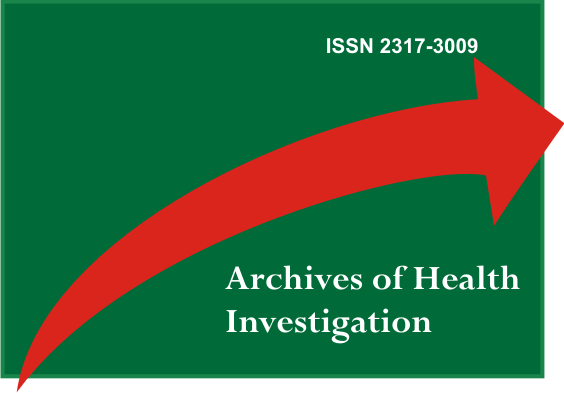Perfil dos pacientes atendidos no Centro de Traumatismo em Odontologia frente às fraturas coronárias e suas sequelas
DOI:
https://doi.org/10.21270/archi.v6i6.2069Abstract
O traumatismo dentário é um evento bastante comum, representando uma situação de urgência que compreende questões físicas e psicológicas. O objetivo deste trabalho foi determinar a prevalência das fraturas coronárias em dentes permanentes e também uma possível complicação, como a necrose pulpar, decorrente do traumatismo dentário. Este estudo transversal e retrospectivo foi realizado por meio da avaliação dos prontuários e exames radiográficos de um centro de referência em traumatismos dentários na cidade de Maringá-PR, entre os períodos de janeiro de 2008 a dezembro de 2014. Os dados demográficos de interesse foram: sexo, idade do paciente no momento da injúria traumática, dente acometido, causa, tipo da injúria traumática, estágio de desenvolvimento radicular e presença de necrose pulpar. O sexo masculino (68%) foi mais acometido que o sexo feminino (32%), sendo que as injúrias ocorreram mais frequentemente nos pacientes com idade entre 6-11 anos (60%). O incisivo central superior foi o dente mais afetado (74%) e a injúria mais frequente foi fratura de esmalte e dentina sem exposição pulpar (70%). A necrose pulpar foi observada em 14% das fraturas coronárias. O teste exato de Fisher não demonstrou uma associação entre a necrose pulpar e as fraturas coronárias (p=0,1153) e entre a necrose pulpar e o estágio de desenvolvimento radicular (p=0,191). A prevalência de fraturas coronárias é maior em crianças e adolescentes. Uma frequência pequena de necrose pulpar foi observada e não se observou uma associação com as fraturas coronárias e o estágio de desenvolvimento radicular.Descritores: Traumatismos Dentários; Prevalência; Necrose da Polpa Dentária.
Downloads
References
Cortes MI, Marcenes W, Sheiham A. Impact of traumatic injuries to the permanent teeth on the oral health-related quality of life in 12-14-year-old children. Community Dent Oral Epidemiol. 2002; 30(3):193-8.
Azami-Aghdash S, Ebadifard Azar F, Pournaghi Azar F, Rezapour A, Moradi-Joo M, Moosavi A, et al. Prevalence, etiology, and types of dental trauma in children and adolescents: systematic review and meta-analysis. Med J Islam Repub Iran. 2015; 29(4):234.
Granville-Garcia AF, de Menezes VA, de Lira PI. Dental trauma and associated factors in Brazilian preschoolers. Dent Traumatol. 2006; 22(6):318-22.
Toprak ME, Tuna EB, Seymen F, Gençay K. Traumatic dental injuries in Turkish children, Istanbul. Dent Traumatol. 2014; 30(4):280-4.
Díaz JA, Bustos L, Brandt AC, Fernández BE. Dental injuries among children and adolescents aged 1-15 years attending to public hospital in Temuco, Chile. Dent Traumatol. 2010; 26(3):254-61.
Kovacs M, Pacurar M, Petcu B, Bukhari C. Prevalence of traumatic dental injuries in children who attended two dental clinics in Targu Mures between 2003 and 2011. Oral Health Dent Manag. 2012; 11(3):116-24.
Olsburgh S, Jacoby T, Krejci I. Crown fractures in the permanent dentition: pulpal and restorative considerations. Dent Traumatol. 2002; 18(3):103-15
Love RM, Jenkinson HF. Invasion of dentinal tubules by oral bacteria. Crit Rev Oral Biol Med. 2002; 13(2):171-83.
Breik O. Discuss how the management of trauma to the dentition is influenced by the type and severity of injury. Aust Endod J. 2008; 34(3):120-5.
Ravn JJ. Follow-up study of permanent incisors with enamel-dentin fractures after acute trauma. Scand J Dent Res. 1981; 89(5):355-65.
Andreasen FM, Pedersen BV. Prognosis of luxated permanent teeth - the development of pulp necrosis. Endod Dent Traumatol. 1985; 1(6):207-20.
Bakland LK, Andreasen JO. Dental traumatology: essencial diagnosis and treatment planning. Endod Topics. 2004; 7(1):14-34.
Andreasen JO. Luxation of permanent teeth due to trauma. A clinical and radiographic follow-up study of 189 injured teeth. Scand J Dent Res. 1970; 78(3):273-86.
Andreasen FM. Pulpal healing after luxation injuries and root fracture in the permanent dentition. Endod Dent Traumatol. 1989; 5(3):111-31.
Andreasen JO, Andreasen FM. Texto e atlas colorido de traumatismo dental. 3. ed. Porto Alegre: Artmed; 2001.
Jacobsen I. Criteria for diagnosis of pulp necrosis in traumatized permanent incisors. Scand J Dent Res. 1980; 88(4):306-12.
Andreasen FM, Zhijie Y, Thomsen BL. Relationship between pulp dimensions and development of pulp necrosis after luxation injuries in the permanent dentition. Endod Dent Traumatol. 1986; 2(3):90-8.
Stockwell AJ. Incidence of dental trauma in the Western Australian School Dental Service. Community Dent Oral Epidemiol. 1988; 16(5):294-8.
Gábris K, Tarján I, Rózsa N. Dental trauma in children presenting for treatment at the Department of Dentistry for Children and Orthodontics, Budapest, 1985-1999. Dent Traumatol. 2001; 17(3):103-8.
Taiwo OO, Jalo HP. Dental injuries in 12-year old Nigerian students. Dent Traumatol. 2011; 27(3):230-4.
Cavalleri G, Zerman N. Traumatic crown fractures in permanent incisors with immature roots: a follow-up study. Endod Dent Traumatol. 1995; 11(6):294-6.
Hecova H, Tzigkounakis V, Merglova V, Netolicky J. A retrospective study of 889 injured permanent teeth. Dent Traumatol. 2010; 26(6):466-75.
Wang C, Qin M, Guan Y. Analysis of pulp prognosis in
permanent teeth with uncomplicated crown fracture with or without luxation. Dent Traumatol. 2014; 30(5): 333-7.
Robertson A, Andreasen FM, Andreasen JO, Norén JG. Long-term prognosis of crown-fractured permanent incisors. The effect of stage of root development and associated luxation injury. Int J Paediatr Dent. 2000;10(3):191-9.
Andreasen FM, Kahler B. Pulpal response after acute dental injury in the permanent dentition: clinical implications-a review. J Endod. 2015; 41(3):299-308.


